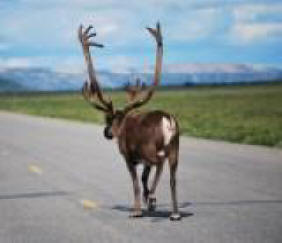Dall sheep live in the mountain regions of Alaska where there is rocky terrain and steep, inclined land. The mountain setting is an ideal place for them to rest and feed. They are occasionally seen below their usual high elevation only when food is scarce. Alaska contains a good size population of Dall sheep. In their rocky environment, they are able to avoid predators and human activities.
These white creatures are most notable for the males’ massive curled horns. Females (known as ewes) also carry horns, but theirs are shorter and more slender, and only slightly curved. Until rams reach the age of 3 years, they tend to resemble the ewes quite a bit. After that, continued horn growth makes the males easily recognizable. Horns grow steadily during spring, summer, and early fall. In late fall or winter, horn growth slows and eventually ceases. This start-and-stop growth results in a pattern of rings called annuli which are spaced along the length of the horn, and can help determine age. Dall rams as old as 16 years have been seen, and ewes have been known to reach 19 years of age. Generally, however, a 12 year old sheep is considered quite old.
Dall sheep are typically all white in color, although a few black hairs on the tail are not uncommon. The white coat is an adaptation, or special trait that helps them survive. Dall sheep typically move to lower altitudes in the winter, but predators are more numerous there. The white coat helps the sheep go unseen against the snow by predators. In the summer months, their coat does not change color, but stays white. They are still protected, however, because they move to steep and rocky cliffs where predators are hard-pressed to follow.
All ungulates walk on hoofed toes. Hooves are made of keratin, which encases the toe bones. Dall sheep walk on two toes which places them in the “even-toed” group of ungulates similar to giraffes, deer, and camels. Hooves are another adaptation that enable Dall sheep to live on rocky, steep terrain. Their toes are flexible and able to adjust to the uneven surfaces in their mountain habitats where sure footing is essential.
Dall sheep feed primarily on grasses and sedges. In the winter they actually eat frozen grass, stems, lichen, and moss. Sheep will often travel to mineral licks to eat soil. These are typically rocky outcrops where high concentrations of minerals are pooled. This replenishes essential minerals that the sheep cannot get from their daily diet of plants.
Since they eat a variety of plants, sheep have developed special adaptations for their eating habits. They have lost their canine teeth but have developed large, flat cheek teeth with raised ridges. When chewing, the teeth move side-to-side and front-to-back in a triangular motion to grind food. Strong lips and tongue are designed to grab and tear foliage and other vegetation. Special stomach chambers allow ungulates to digest plant material. Ruminants, such as Dall sheep, have a complex stomach made up of four chambers. One chamber has bacteria that ferments the food and breaks down the plant material for absorption. After the food is fermented, the sheep regurgitates it and chews the food again. This second chewing is called rumination. After the second chewing, the food goes through the other three chambers and then to the intestines. It may take 4 days to digest a meal completely! Like other ungulates, Dall sheep have well-developed senses. Their long noses are filled with olfactory nerves to help them detect predators. Large ears can rotate to detect sounds from all directions. Big eyes, set on the sides of their heads let them see in many directions at the same time.
Dall sheep have well developed social systems. Adult rams live in bands, or groups, associated with ewe groups during the mating season. Since Dall sheep are very loyal to their social group, they have very specific home ranges (a geographic area where they normally live). After joining a social group, sheep are never known to leave it. One adaptation of living in a social group is safety from predators. With so many eyes watching for a sign of danger, a predator can be spotted sooner so the whole group can flee.
The primary predators of Dall sheep are wolves, coyotes, black bears, and grizzly bears; golden eagles are predators of the young. Dall sheep can often be observed along the Alaska Highway at Muncho Lake and at Sheep Mountain in Kluane National Park and Reserve, as well as near Faro, Yukon (Fannin's sheep).
|








